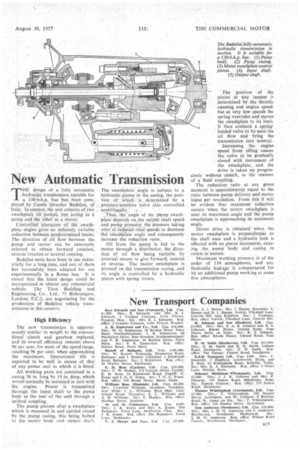New Automatic Transmission HE design of a .fully• , antornatic T •
Page 49

If you've noticed an error in this article please click here to report it so we can fix it.
hYdratdie transmission, suitable for a 130-bh.p. btiS• has. been . com. pieta . by Cambi ldrantici'Badalini, of Italy. In essence, the Unit cninists of two , swashplafe Oil pumps, one acting as a pump and the other' as a motor.
Controlled -alteration of the .swaSh• plate .angles gives an infinitely variable, reduction between predetermined limits. The direction of oil flow between the pump and motor can be externally selected to obtain forwardrotation, reverse rotation or neutral running.
-Badalini units have been in use industrially for a long time, and one of them has suecessfuly been adapted for use experimentally in a Rome bus. It is stated that the latest design could be incorporated in almost any commercial vehicle. The Titan Building and Engineering Co., Ltd.. 75 Bishopsgate, London, E.C.2, are negotiating for the production of Badalini vehicle transmissions in this country.
High Efficiency The new transmission is approximately similar in weight to the conventional clutch and gearbox replaced, and its overall efficiency remains above 90 per cent, for most of the speed range, reaching 96 per cent. when approaching the maximum. Operational life is expected to be well in excess of that of any. power unit to which it is fitted.
All working parts are contained in a casing 30 in. long by 19 in. deep, which would. normally be mounted in unit with the engine. Power is transmitted through the input shaft to the pump bodY• at the rear of the unit through a splined coupling.
The pump pistons abut a .swashplate which is mounted in and carried round by the pump casing, this being bolted to the motor body and output shaft. The swashplate angle is subject to a hydraulic-piston in the easing, the position of which.: is determined by a pressure sensitive 'Valve also controlled centrifugally.. Thus, the angle of the phrup swathplate depends on the outpilt shaft speed and pump Pressure, the pressure taking over at reduced read speeds to decrease the' sWashniate angle and consequently increase the reduction ratio.
Oil from the pump is fed to the motor through a distributor, the direction of oil flow being variable by external means to give forward, neutral or reverse. The motor swashplate is pivoted on the transmission casing, and Its angle is controlled by a hydraulic piston with spring return.
The " positionof the piston at any instant it determined by the throttle opening and engine speed, but at very low speeds the spring overrides and moves the swashplate to its limit. It .then contacts a spring: loaded valve to by-pass the oil flow and bring the transmission into neutral.
Increasing the engine speed from idling causes the valve to be gradually closed with movement of the swashplate, and the drive is taken up progressively without snatch, in the manner of a fluid 'coupling.
The reduction ratio at any given moment is approximately equal to the ratio between pump delivery and motor input per revolution. From this it will be evident that maximum reduction occurs when the motor swashplate is near its maximum angle and the pump swashplate is approaching its minimum angle.
-Direct drive is obtained when the motor swashplate is perpendicular to the shaft axes and a hydraulic lock is effected with no piston movement, causing the pump body and easing to rotate in unison.
Maximum working pressure is of the order of 110 atmospheres, and any hydraulic leakage is compensated for by an additional pump working at some five atmospheres.




























































































